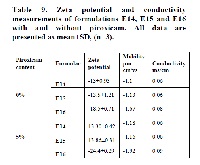Formulation and characterization of palm oil esters based nanocream for topical delivery of piroxicam
Keywords:
Palm oil esters, Piroxicam Solubility, partition coefficient, Rheology, Surface activityAbstract
Palm oil esters are high molecular weight esters oil that has been newly synthesized by University Putra Malaysia researchers. It has received a lot of attention for its pharmaceutical and chemical application. Piroxicam is a nonsteroidal anti-inflammatory drug with analgesic and antipyretic activity. It has low solubility in water as well as in oil with Log P value of 1.8. Generally, drugs with Log P value of more than 0.5 are needed to be formulated into a modified dosage form. One of these formulations is nano sized cream. Hence, the ability of formulating of these tricky drugs into dispersed system is questionable. The aim of this study is to investigate the ability of palm oil esters to be the oil phase for formulation of piroxicam into O/W nano-cream. Three points were selected from prepared pseudoternary diagram of palm oil esters and different Tween and Span mixtures. Piroxicam solubility and partition coefficient in oil and external phase was detected. Rheological properties, droplet size, structural properties and zeta potential of the dispersion system containing piroxicam were measured. O/W cream was formed with droplet size measurement by TEM of less than 100 nm. It could be concluded that palm oil esters is suitable oil for the formulation of suitable nano-cream containing piroxicam.
References
Keng PS, Mahiran B, Abdul Rahman MB, Salleh
AB, Abdul Rahman RNZ, Ariff A: Optimization
of palm-based wax esters production using
statistical experimental designs. J. Oleo Sci 2005;
:519-528.
Keng PS, Basri M, Ariff AB, Abdul Rahman MB,
Abdul Rahman RNZ, Salleh AB: Scale-up
synthesis of lipase-catalyzed palm esters in
stirred-tank reactor. Bioresource Technol 2008;
:6097-6104.
Keng PS, Basria M, Zakaria MRS, Abdul Rahman
MB, Ariff AB, Abdul Rahman RNZ, Salleh AB:
Newly synthesized palm esters for cosmetics
industry. Ind Crop Prod 2009, 29:7-4.
Idson B: Pharmaceutical emulsions. In:
Lieberman HA, Rieger MM, Banker GS (eds):
Pharmaceutical dosage form disperse system.
New York: Marcel Dekker, 199-241, 1988.
Raymond CR, Sheskey PJ, Wen SC: Handbook of
Pharmaceutical Excipients. London:
Pharmaceutical Press, 2003
Gupta PK, Cannon JB: Emulsion and microemulsion for drug solubilization and delivery. In:
Liu R. (ed): Water-insoluble drug formulation.
New York: CRC Press, 51-680, 2000.
Roberts M, Cross S: Percutaneous absorption of
topically applied NSAIDs and other compounds:
Role of solute properties, skin physiology and
delivery systems. Inflammopharmacol 1999;
:339-350.
Hadgraft J, Plessis JD, Goosen C: The selection of
non-steroidal anti-inflammatory agents for dermal
delivery. Int J Pharm 2000; 207:31-38.
Park E, Cui Y, Yun B, Ko I, & Chi S:
Transdermal delivery of piroxicam using
microemulsions. Arch Pharm; 2005; 28:243-248.
Thierry VH, Geraldine P, Henry DHS, Brigitte E,
Luc D: Determination of the free/included
piroxicam ratio in cyclodextrin complexes:
Comparison between UV spectrophotometry and
differential scanning calorimetry. Eur J Pharm Sci
; 15:347-353.
Welin-Berger K, Neelissen JAM, Bergenstàhl BR:
The effect of rheological behaviour of a topical
anaesthetic formulation on the release and
permeation rates of the active compound. Eur J
Pharm Sci 2001; 13:309-318.
Qiao Y, Xia S, Ma P: Octanol/Water partition
coefficient of substituted benzene derivatives
containing halogens and carboxyls: Determination
using the shake-flask method and estimation using
the fragment method. J Chem Eng Data 2008;
:280-283.
Rangel-Yagui CO, Hsu HWL, Pessoa-Jr A,
Tavares LC. Micellar solubilization of ibuprofen –
influence of surfactant head groups on extent of
solubilization. Braz J Pharm Sci 2005; 41:237-
14. Sinko PJ: Martin's physical pharmacy and
pharmaceutical sciences: Physical chemical
principles in the pharmaceutical sciences.
Philadelphia: Lippincott Williams and Wilkins,
Jiao J, Burgess DJ: Rheology and stability of
Water-in-Oil-in-Water multiple emulsions
containing Span 83 and Tween 80. AAPS J 2003;
:1-12.
Gullapalli R, Sheth B: Influence of an optimized
non-ionic emulsifier blend on properties of oil-inwater emulsions. Eur J Pharm Biopharm 1999;
:233-238.
Lashmar UT, Beesley J: Correlation of
rheological properties of an oil in water emulsion
with manufacturing procedures and stability. Int J
Pharm 1993; 91:59-67.
Mortensen K: Structural studies of lamellar
surfactant systems under shear. Curr. Opin 2001;
:140-145.
Davis SS: Viscoelastic properties of
pharmaceutical semisolids I: Ointment bases. J
Pharm Sci 1969; 58:412-418.
Niraula B, King TC, Misran M: Evaluation of
rheology property of dodecyl maltoside, sucrose
dodecanoate, Brij 35 and SDS stabilized O/W
emulsion: Effect of head group structure on
rheology property and emulsion stability. Colloids
and Surface A 2004; 251:59-74.
Adeyeye MC, Jain AC, Ghorab M, Reilly WJ:
Viscoelastic evaluation of the topical creams
containing microcrystalline cellulose/sodium
carboxymethyl cellulose as stabilizer. AAPS
PharmSciTech 2002,3:1-10.
Ajith S, Rakshit AK: Studies of mixed surfactant
micro-emulsion systems: Brij 35 with tween 20
and sodium dodecyl sulfate. J Phyis Chem 2005;
:4778-4783.
Marrzan LL, Samseth J, Quintela MAL: Structure
of concentrated nonionic surfactant microemulsions studied by small angle neutron
scattering. Journal De Physique IV 1993, 3:165-
Dodge LG, Rhodes DJ, Reitz RD: Drop-size
measurement techniques for sprays: comparison
of malvern laser-diffraction and aerometrics
phase/Doppler. Appl Optics 1987; 26:2144-2154.
Junginger, H. E. Ointments and creams as
colloidal drug delivery system. In: J. Kreuter,
(ed). Colloidal Drug Delivery Systems. New
York: Marcel Dekker. 1994 pp. 1-45.
Uchegbu IF, Florence AT: Non-ionic surfactant
vesicles (niosomes): Physical and pharamceutical
chemistry. Adv Colloid Interfac 1995; 58:55.
Elworthy PH, Florence AT: Stabilization of oil in
water emulsions by non-ionic detergents:
Electrical and entropic contributions to stability. J
Pharm Pharmacol 1969; 21: 11.
Sis H, Birinci M: Effect of nonionic and ionic
surfactants on zeta potential and dispersion
properties of carbon black powders. Colloids and
Surface A 2009; 341:60-68.






